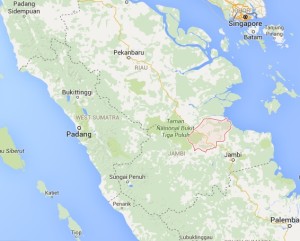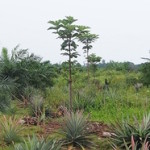By Ivanna Patton, La Nguyen and Ake E Mamo, originally published at ICRAF’s Agroforestry World Blog
Northwestern Vietnam is home to the three poorest provinces of the country, with a combined population of 3.4 million people and poverty ranging from 32% to 48% of households across provinces. There is a culturally diverse mix of communities comprising 30 ethnic groups but land use is dominated by maize production, largely sold for use as pig feed, on recently deforested slopes that are subject to high degradation rates.
In Son La province, for example, 65 000 ha of natural forest was converted to commercial maize cultivation between 2002 and 2009. In some areas shifting cultivation of upland rice, maize, soybean and cassava is still practiced but population pressures are shortening natural fallow periods, resulting in continuous cultivation with very little attention to erosion control measures exacerbating high economic and environmental risks.
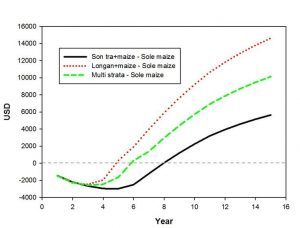
Most agricultural crops are grown as monocultures on steep slopes, subject to soil degradation and declining crop yields. It is estimated from soil erosion measurements in farm trials, that typical erosion rates under maize monoculture in Yen Son district were almost 70 t ha-1 yr-1.
Agroforestry practices, involving contour planting of high value fruit and timber trees are a potential option for halting and reversing land degradation, improving ecosystem functions and enhancing the profitability of farming systems.
At the inception of the research reported here, agroforestry did not feature as an option in government policy at provincial or district level, and practical options for integrating trees on farms were not well developed in the region. There were only a few tree nurseries, generally producing germplasm of uncertain quality for a very narrow range of tree species. Farmers were further disadvantaged by low prices for products as a result of poor market access resulting from lack of infrastructure and market information, low and uncertain product quality along value-chains and lack of market links that affected the poorest disproportionately, leaving few livelihood options but subsistence agriculture.
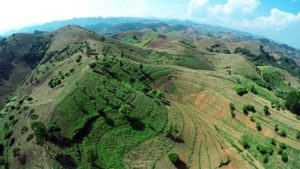
Recognizing the potential of agroforestry, the World Agroforestry Centre (ICRAF) in Vietnam, with support from the Australian Centre for International Agricultural Research (ACIAR) and CGIAR research programme on Forests, Trees and Agroforestry implemented a comprehensive 5 year (2011 – 2016) agroforestry research project with local partners to improve the performance of smallholder farming systems in Northwestern Vietnam.
“We sought to increase the productivity of associated crop and livestock systems, leading to more diverse and sustainable production systems and better income from tree products.” Says Delia Catacutan, Head of the ICRAF Office in Vietnam. “The project took advantage of recent improvements in infrastructure which facilitate market access and increased livelihood opportunities.”
The project titled: ‘Agroforestry for livelihoods of smallholder farmers in Northwest Viet Nam (AFLi)’ had four specific and interconnected objectives. The first was to develop viable agroforestry practices for three altitudinal zones (<600 m.a.s.l., 600-800 m.a.s.l. and >800 m.a.s.l.), involving active engagement of local people in the design and testing of agroforestry options through on-farm trials.
The second was to improve the availability of high-quality germplasm to enable the expansion of agroforestry, addressing issues of germplasm availability, quality and multiplication. The third objective was to enhance market access and opportunities for adding value to agroforestry products and the fourth was to facilitate policy dialogues and develop extension methods for widescale promotion of agroforestry across the region.
The main assumption underpinning and being tested in this work was that integration of well-chosen tree species into the farming systems and landscapes of Northwestern Vietnam will make production systems more profitable, environmentally sustainable and resilient.
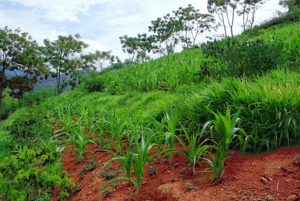
“We built on existing agroforesty knowledge and ongoing research in North-West Vietnam, and put a strong emphasis on understanding the interactions between trees and livelihoods under different agro-ecological and socio-economic conditions in order to facilitate subsequent dissemination and adoption of agroforestry practices.” Says Dr La Nguyen, Project Leader of AFLi.
The project benefited from FTA’s global network of agroforestry research, specifically through introduction of successful sloping agricultural land technology from the Philippines and research on market development for agroforestry products and extension approaches from Indonesia and Cameroon.
FTA funds also enabled the project to respond both to farmer needs (through adding more diverse, multistrata practices to the range of options being evaluated) and opportunities to engage policy makers (through co-investment with provincial Departments of Agriculture and Rural Development (DARDs) to initiate a network of exemplar landscapes that showcase landscape transformation when agroforestry practices are adopted at scale in a given area).
This complementarity of flexible funds from FTA alongside the programmatic funding from ACIAR was important in ensuring that the research was locally relevant and that outputs were taken up at national and provincial levels.
At the end of the project in 2016, AFLi reported significant outcomes ranging from capacity strengthening, to economic, social and environmental benefits across the farming systems of Northwestern Vietnam.
Capacity outcomes: awareness, knowledge and skills. A key indicator measured against AFLi’s four project objectives is improving farmers’ awareness, knowledge and skills on establishing and managing agroforestry practices, including seedling/germplasm production and marketing. The project trained a significant number of stakeholders (lead farmers, extension staff and researchers) and raised awareness amongst key policy makers, who now provide a critical mass of expertise that can promote agroforestry practices across the region.
More than 2,000 people including farmers, extension workers and research partners were trained on different aspects of agroforestry including agroforestry design, tree pruning, seed and seedling production, and contouring. The introduction of farmer innovations from the Philippines including the pragmatic ‘ox back method’ for laying out contours rather than more cumbersome use of ‘A’ frames and the incorporation of cash crops in vegetation strips designed primarily to control erosion, were particularly valued by farmers.
A monitoring and evaluation survey showed that 73% of farmers in areas where training had been conducted knew the key elements required to implement agroforestry on farms, and were provided with adequate technical support from extension workers to establish agroforestry practices on their farms. The demonstration from the participatory farmer trials that agroforestry practices were a viable option in the region has raised awareness amongst policy makers leading to policy change at provincial and district levels (these are catalogued below), promoting and providing incentives for farmers to adopt agroforestry.
Through the development of a network of exemplar landscapes across the region in conjunction with provincial DARDs, it is anticipated that these trained farmers, research and extension staff will provide a critical nucleus of expertise to underpin widespread promotion of agroforestry – a strategy endorsed through ACIAR funding of a second phase AFLi project with a 60% higher budget than the first phase.
Economic outcomes: income and productivity. Seven agroforestry options involving different combinations of fruit and timber trees with grass strips and maize were evaluated through participatory on farm trials over 3-4 years indicating higher productivity and profitability compared to maize monoculture. With most practices, net cashflow compared to maize monoculture was initially negative with investment costs greater than immediate returns, becoming positive after five years and then predicted to rise sharply (Figure 1).
For example, with longan-maize-forage intercropping, forage grass was the main income source in the first year, while income from maize started to pick up in the second year, and longan trees started to bear fruits in the third year and produce substantial yields from year five. Average annual incomes from the different agroforestry practices by their third year ranged from 16 to 38 million VND (700 – 1650 USD) ha-1 compared to an average of 12.5 million VND (544 USD) ha-1 for maize monoculture. There is also reduction in soil loss from agroforestry that could be valued at 5.7 million VND (250 USD) ha-1 which is the cost of replacing the NPK lost through erosion by purchasing fertilizer.

Discounted cash flow (cumulative Net Present Value of agroforestry practices over a maize monoculture) calculated using production data from trials supplemented by information from mature trees and a 10% discount rate.
The trials show the potential for agroforestry to substantially increase household income in the medium term but also indicate that farmers, particularly those in cash-poor households, are likely to need financial assistance to establish agroforestry, that provincial governments are now beginning to provide through incentive schemes and input subsidy (see below). For households with livestock, the use of grass strips provides immediate benefit from the value of livestock fodder, also critical for controlling livestock grazing to prevent damage to establishing trees.
Farmers showed a preference for more diverse agroforestry options involving several tree species, creating more relisient production systems in the face of anticipated price fluctuations for different products. The potential areas suitable for agroforestry expansion are 495,000 ha across Son La, Yen Bai and Dien Bien provinces, and using S-shaped diffusion curves to predict adoption with different assumptions regarding policy incentives and uptake it is estimated that from 128 to 250 thousand households could benefit over a fifteen year period of promotion.
Social outcomes: building social capital and growing markets. A co-investment scheme to support the establishment of exemplar agroforestry landscapes was facilitated by AFLi through building social capital amongst farmers, between farmers and extension workers and researchers, and between project staff and provincial governments.
For example in Na Ban village in Mai Son district, around a third of the farmers initially volunteered to put trees on their farms with technical assistance provided by the Son La extension centre and co-financing from the provincial DARD. This resulted in 50 ha of agroforestry in a landscape about three times that size, creating a showcase for how agroforestry can transform people’s lives and their landscsape. Nearly all the farmers in the landscape are now interested in adopting agroforestry and the provincial DARDs are co-investing in establishing a network of six exemplar landscapes across the region as focal points for promting agroforestry.
The project also facilitated partnership-building with the private sector, to grow the market for son tra (Docynia indica) an indigenous fruit tree which is being domesticated and promoted within the AFLi project. Farmers can earn high incomes from growing the fruit, but as more farmers adopt improved tree germplasm, supply will increase and market prices would be expected to fall unless the market for the fruit expands. To effect this the project worked with National Institute of Medicinal Material in Hanoi (NIMM) and the Tay Bac Tea and Special Food company to develop non-perishible products from son tra including dried tea and extract that suit the urban market in Vietnam as well as creating the potential for export. The project is now working with the district government of Bac Yen, local farmers and the food company, to secure sustainable supply of quality son tra fruits for the market at attractive prices for producers.
Environmental outcomes: Soil erosion trials have shown that agroforestry is far more effective in controlling soil erosion than monoculture practices. Compared to maize monoculture system, for example, the longan-maize-forage grass system on the 3rd year, suggest a reduction in soil loss by up to 56%; 23% in teak-plum-coffee-soybeans-forage grass; up to 90% in acacia-longan-coffee-forage grass system; and up to 74% in acacia-mango-maize-forage grass system. Once the trees reached maturity stage and the grass strips have become stable, erosion can be expected to be 90% less to zero. Not to mention improvements in on-farm biodiversity, the more than 60,000 trees of 18 fruit and timber species, planted by farmers in exemplar landscapes and FDTs would have significantly increased tree cover in the landscape with carbon sequestration benefits.
Contributing to change: AFLi research had a key strategy of harnessing volunteerism, co-operation and co-investment in its expansion from trial agroforestry systems to the establishment of on-station and on-farm trials and the management and monitoring of those trials, including research on propagation of priority agroforestry species and small-scale nursery development. And then to enhancing market access for focus species then exploring value-adding opportunities by smallholders and facilitating links between producers and other market actors. The key outputs from the strategy were disseminated through farm cross-visits, farmer field days and training sessions held at the test sites, accompanied by regular impact assessments and policy dialogue.
Research findings were used to inform the communication strategies, policy dialogues, extension and expansion activities through workshops, media products, extension materials and training. This also involved major dissemination efforts through a network of farmer demonstration trials (FDT) and agroforestry exemplar landscapes to demonstrate large-scale agroforestry adoption. Outcome mapping was used to document the influence of the project on policy processes.
Communication and dissemination through various means (TV shows, videos, fact sheets, conference presentations, photo exhibits, blog stories, policy dialogues and training events) were critical to increasing the project’s visibility.
The project produced seven videos, of which, two were nationally broadcast. It also produced 17 blog stories, eight international and Vietnamese journal articles, four working papers, 20 technical reports, 14 extension materials, a fact sheet, a policy brief, and two information brochures. Knowledge was also shared across large networks throughout Asia via presentations in major conferences such as: (1) Conservation Agriculture in Southeast Asia; (2) World Agroforestry Congress; (3) Asia-pacific Farmer’s Association; (4) Southeast Asian Network for Agroforestry Education; (5) and ALiSEA (6). Several other projects have made field visits to see the AFLi project achievements as a direct result of the project’s growing popularity, such as those of the SUFORD-SU PROJECT in Laos PDR, the IFAD-Ha Tinh project on Sustainable Rural Development, and the USAID-funded Green Annamites project.
Government policies and alignment: Through documentation of policy dialogues and processes the project outputs can be shown to have been important in the development of several national, provincial and district level policy instruments. These include:
- Yen Bai provincial Resolution15/2015/NQ-HDND— with provision for financial support of 6 million VND ha-1 for individual households or group of households, to establish son tra-based agroforestry practices in Tram Tau and Mu Cang Chai districts.
- Yen Bai provincial Decision 27/2015/QD-UBND—One time financial support at 1 million VND ha-1 for individual households to establish sustainable maize cultivation on sloping land by planting grasses along contour lines to reduce erosion.
- Yen Bai provincial Decision 2412/QD-UBND—Support for “son tra development in Tram Tau and Mu Cang Chai districts for the period, 2016-2020”. This involves Increasing the total area of son tra plantation to 10,000 ha, improving the existing 3,820 ha son tra plantation through use of better germplasm and management, and son tra planting on 6,200 ha of degraded forest land.
- Minisrtry of Agricultural and Rural Development (MARD) Decision 2477/QD-BNN-HTQT, at national level which created MARD’s Agroforestry Working Group that was set up to:
- Advise MARD on agroforestry development in Vietnam
- Review, improve, and propose agroforestry-related policies
- Cooperate with local provinces, national and international organizations to research and develop agroforestry options for adaptation and mitigation of climate change
- Capacity building for national and local staff and mobilizing funding sources for sustainable agroforestry development
- MARD’s inclusion of agroforestry in the National Action Plan Framework for Adaptation and Mitigation of Climate Change of the Agriculture and Rural Development Sector (2008-2020).
The enactment of above policies plus alignment with the government’s numerous strategies toward rural development green growth, and climate change adaptation and mitigation (ie, Vietnam’s Green Growth Strategy) has and will continue to stimulate wide-scale adoption of agroforestry in the region and beyond.
Some lessons learned were that wider adoption of agroforestry requires a combination of bottom-up and top-down strategies. Bottom-up work was required to develop feasible options with farmers that suit their circumstances; but top-down action from government to sanction and support agroforestry establishement is required for widescale adoption of agroforestry by famers across landscapes where land use is driven by competing, often incentivized options operating together with land designation and regulation.
AFLi as it stands today brings new insights about how smallholder farmers make decisions related to tree planting and adopting new production systems in changing policy, market and environmental contexts. In addition to the relevance of these results to policy makers and extension services, the research findings also enrich the scientific literature on constraints and opportunities for agroforestry adoption and on drivers of land-use change in general.
AFli further contributes to research on the role of indigenous species for afforestation and mixing with conventional trees and crops in agroforestry systems, such as son tra (Docynia indica). New knowledge generated through the trials on propagation methods of this species, productive combinations with other species and its potential to contribute to soil conservation are cornerstones of its domestication. This combines with new insights from value chain research on the opportunities and limitations for diversifying and strengthening existing livelihood options through adding value to products from remote, disadvantaged rural areas.





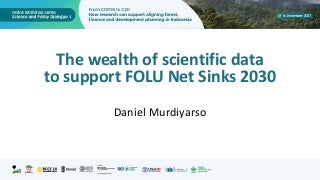
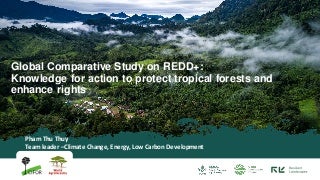





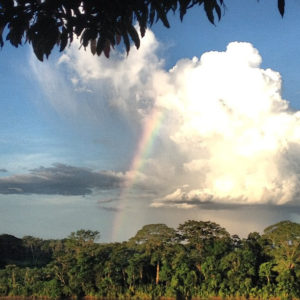



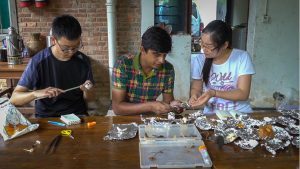

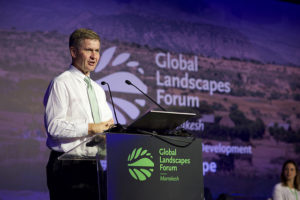 By Leona Liu, originally posted at CIFOR’s
By Leona Liu, originally posted at CIFOR’s 